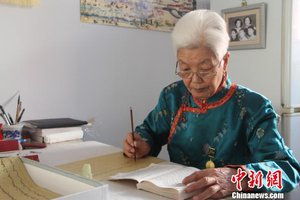 |
| Erdengsubuda, a 78-year old Mongolian woman, transcribes a book with an ink brush at her home in Abag Banner, a county under the administration of Xilin Gol League in north China's Inner Mongolia Autonomous Region. [chinanews.com] |
In her late 70s, a Mongolian grandmother called Erdengsubuda has recently completed transcribing The Secret History of the Mongols, a Mongolian epic chronicle of the 13th century, with ink brushes that are often used in Chinese calligraphy, utilizing painting and descendant brush painting styles.
The Secret History of the Mongols is the oldest surviving Mongolian-language literary work originally written in the Uyghur script, also known as classical Mongolian script, for the Mongol royal family some time after the death of Genghis Khan (1162-1227), the founder and Great Khan (emperor) of the Mongol Empire, which became the largest contiguous empire in history after his demise.
Linguistically, The Secret History of the Mongols provides the richest source of pre-classical Mongolian and Middle Mongolian, and is regarded as a piece of classic world literature.
"I have raced against time to transcribe the great work. It's a big deal for me to have made it," said the 78-year-old who lives in Abag Banner, a county under the administration of Xilin Gol League in north China's Inner Mongolia Autonomous Region.
Since September 2013, Erdengsubuda, who was engaged in education for 35 years before her retirement, began to transcribe The Secret History of the Mongols with ink brushes.
In late February 2014, Erdengsubuda completed her transcription of nearly 700 A4 pages of xuan paper, a high-quality paper made for traditional Chinese painting and calligraphy in Xuancheng, east China's Anhui Province.
Then, Erdengsubuda duplicated them, bound them together into book form and presented her transcribed The Secret History of the Mongols to the Genghis Khan Museum.
Grey-haired Erdengsubuda also plans to work on another copy, hoping to present it to the Abag Banner Museum in the future.
At the mention of her original reason for the transcription, Erdengsubuda said: "I transcribed the book in order to get people to cherish the time-honored Mongolian cultural heritage, love their ethnic culture, and contribute their efforts to protecting and carrying forward Mongolian culture for later generations."
"I just contributed my bit of effort. As long as it does some good to others, I'm ready to take it up again," she added.
Those days, Erdengsubuda got up early every morning and worked on her transcription, stroke by stroke and page by page. In winter, she still woke up on time, turned on the lights and bended over her transcription.
When Erdengsubuda seated herself at the desk for long periods of time, her right hand became limp and numb and her eyes also hurt, compelling her to put down her ink brush.
Later, Erdengsubuda made a rule: writing for one to two hours to complete three to four pages each day. This way, her calligraphy manuscripts accumulated day by day and month by month.
It's a serious thing for her to transcribe the Mongolia epic. "The Secret History of the Mongols is a piece of classic literature in the world with significant academic value. It has been translated into many languages, and experts and scholars of different countries have studied it for 600 years," said Erdengsubuda.
"I must keep a calm heart, hold the ink brush tightly and sit up straight to do the transcription. In addition, the brush, ink and paper should match well to do it well," she added.
As she couldn't find any upside-down xuan paper for Mongolian characters, Erdengsubuda had to use checkered paper for Chinese characters. The ink stone should be kept flat and clean without dry ink marks. "If a single Mongolian character was transcribed wrongly, I had to throw away the whole paper," said Erdengsubuda.
Sadly, Erdengsubuda is not in good health. She underwent several major surgeries in 2013, and had a colostomy bag fitted.
Despite her health problems, Erdengsubuda made it her routine to start her day transcribing the literary work. "I live alone, but I have a lot of things to busy myself with, such as cooking and washing, cleaning the house, reading newspapers and chatting with my friends via WeChat (a mobile text and voice messaging communication service developed by Tencent in China.)"
When she completed her calligraphy manuscripts, Erdengsubuda felt quite satisfied and often looked through them. "There are few other nomadic peoples, like the Mongolian people, who have kept such a systematic, complete and clear classic work to record their history," she said with a sense of excitement and pride.
"I may do some transcribing in the future, but I don't think I can do such a large work due to my ill-health," said Erdengsubuda.
(Source: chinanews.com/Translated and edited by Women of China)










0 comments:
Post a Comment